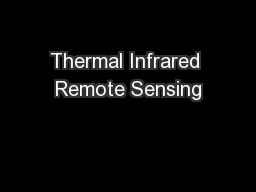

Introduction All previous sensor systems discussed sensing or measuring reflected solar radiation In the thermal infrared we measure emitted terrestrial radiation Energy is first absorbed then is emitted by the object ID: 538269
Download Presentation The PPT/PDF document "Thermal Infrared Remote Sensing" is the property of its rightful owner. Permission is granted to download and print the materials on this web site for personal, non-commercial use only, and to display it on your personal computer provided you do not modify the materials and that you retain all copyright notices contained in the materials. By downloading content from our website, you accept the terms of this agreement.
Slide1
Thermal Infrared Remote SensingSlide2
Introduction
All previous sensor systems discussed sensing or measuring
reflected solar radiationIn the thermal infrared we measure emitted terrestrial radiationEnergy is first absorbed, then is emitted by the object
Emitted
Absorption
ReflectedSlide3
Comparison of Reflective and Thermal Bands
Landsat 7 ETM+ dataSlide4
Day and Night Thermal Images
Lillesand & KieferSlide5
The level of radiation emitted by objects is determined by their
temperature
emissivityAbsorption, not scattering, is the dominant atmospheric effectSlide6
Temperature
Concentration of internal thermal energy
is a measure of the average kinetic energy of atomic and molecular motions within bodies above absolute zero (0 degrees Kelvin)Interactions (collisions) among these units lead to changes in energy --- emitted as radiation that can be detected externally.Slide7
Thermal Energy of an Object is Indicated by its:
Kinetic Temperature
is measured by a thermometeralso called internal, real, contact and thermodynamic temperatureRadiant Temperatureis measured by a radiometeralso called external, apparent and non-contact temperatureSlide8
Relation between Kinetic and Radiant Temperatures
If the emissivity of an object is 1 (i.e., a perfect blackbody), then its kinetic temperature equals its radiant temperature
But, for natural or graybodies, the kinetic and radiant temperatures differ according to the emissivity of the bodySlide9
Radiant temperature -- the quantity measured by remote sensors -- can be derived from the Stefan-
Boltzman
law Trad =
1/4
Tkin
Emissivity () controls the radiant temperature of an object
two objects with the same kinetic temperatures, but different emissivities
will have different radiant temperaturesSlide10
Summary of Basic Thermal Properties
Temperature of an object measured remotely is known as its radiant or apparent temperature
Radiant temperature is the blackbody or kinetic temperature reduced by its emissivityRemotely sensed thermal IR radiances are a composite of emitted energy, emissivity, and atmospheric and sensor effectsSlide11
Time of day is critical to assessing temperature response patterns
Diurnal Variation in Radiant Temperatures
Noon
Dawn
Sunset
Radiant Temperature
Avery & Berlin, 1992Slide12
Reflective Bands
Death Valley, Nevada
Thermal Infrared BandsSlide13
Thermal IR image of Lake Tahoe over Landsat TM imageSlide14
Thermal and Visible Images of Glen Canyon and Surrounding SandstoneSlide15
Urban Heat Island Effects
Surface Temperature
Feb. 27, 2001
282K
251K
MUSA Boundary
St. Paul
MinneapolisSlide16
Minneapolis
St. Paul
Urban Heat Island Effects
Surface Temperature
July 16, 2002
318K
251K
MUSA BoundarySlide17
Day (left) and night (right) thermal images of a power plant with plume of hot water coming into river
An example of density slicing
Lillesand & KiefferSlide18
Detection of Building Heat Loss
Remote Sensing TutorialSlide19
Fire DetectionSlide20
Atlantic Gulf Stream Temperatures
temperature range,
5 – 25 CSlide21
Global Sea Surface Temperature